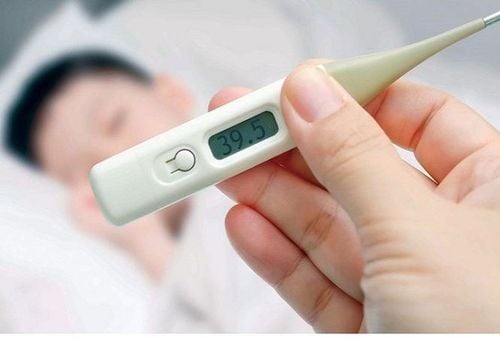This is an automatically translated article.
The article is professionally consulted by MSc Nguyen Thi Ngoc - General Doctor, General Health Examination Unit, Vinmec Central Park International General Hospital.Dengue fever is an acute infectious disease, which can cause epidemics, caused by the dengue virus. In Vietnam, the disease occurs all year round, but often breaks out into a major epidemic in the rainy season, especially in July, August, September and October. In the face of the 2019 dengue epidemic situation across the country, there is a complicated development. complicated, families need to be alert to the signs of dengue fever to prevent & treat promptly
1. Classification of degrees of dengue fever
Dengue fever is divided into 3 levels (According to the World Health Organization - WHO in 2009):Dengue hemorrhagic fever. Dengue hemorrhagic fever has warning signs. Severe Dengue Hemorrhagic Fever (Dengue Hemorrhagic Shock).
2. Signs to identify each level of dengue fever
Dengue fever has a variety of symptoms, ranging from mild to severe. The disease usually has a sudden onset and progresses through three stages: the febrile phase, the critical phase, and the convalescent phase.It should be noted that the fever stage corresponds to the normal form of Dengue hemorrhagic fever, if it has passed the dangerous stage, it has changed to the level of the dengue fever with warning signs and Dengue hemorrhagic fever. heavy . At that time, it is necessary to send the patient to the hospital immediately because it can lead to dangerous complications. Early detection of the disease and understanding the clinical problems in each stage of the disease will help early diagnosis, correct and timely treatment, in order to save the patient's life.
Febrile phase The febrile phase will appear after the incubation period, which lasts 4 to 10 days after being bitten by an infected mosquito.
Patient has signs of sudden high fever, continuous 39-40 degrees Celsius, lasting 2-7 days, difficult to reduce fever. Severe headache in the forehead area, pain in the eyes behind the eyeballs. There may be rash, rash, skin congestion. Loss of appetite, nausea. Muscle pain, joint pain. Positive ligature test.
Sốt cao khó hạ là triệu chứng điển hình của sốt xuất huyết
Plasma leakage due to increased vascular permeability (usually lasts 24 - 48 hours); pleural effusion, interstitial tissue, peritoneum, eyelid swelling, hepatomegaly, may be painful. If there is a lot of plasma leakage, it will lead to shock with signs of palpitations, restlessness or lethargy, cold extremities, cold and moist skin, small rapid pulse, stuck blood pressure (maximum and minimum blood pressure difference ≤ 25 mmHg. ), low blood pressure or unmeasured blood pressure, little urine. Hemorrhage: Subcutaneous haemorrhage, sporadic purpura or petechiae, usually on the front of the legs and on the insides of the arms, abdomen, thighs, ribs, or bruises. Hemorrhage in the mucosa: Bleeding from the nose, gums, blood in the urine. Menstruation lasts or occurs earlier than the period. Visceral bleeding such as: gastrointestinal, lung, brain are severe manifestations (vomiting/vomiting blood, black stools due to internal bleeding). In some cases of severe dengue fever, there may be signs of organ failure such as severe hepatitis, encephalitis, myocarditis. These severe manifestations may occur in patients with no obvious signs of plasma leakage or in shock. Abdominal pain, nausea, cold hands and feet, panicking (this is a shock syndrome caused by internal bleeding causing blood loss and lowering blood pressure), requiring immediate emergency care.
Xuất huyết dưới da thường xuất hiện trong giai đoạn nguy hiểm của bệnh
Recovery phase About 24 - 48 hours after the dangerous phase, the patient's body gradually reabsorbs fluid from the interstitial tissue into the lumen, this phase will last for about 48 - 72 hours.
The patient is fever free, his general condition is better, his appetite is back, hemodynamic stability is stable, and he urinates a lot. There may be bradycardia and ECG changes. During this period, excessive fluid administration to the patient can cause pulmonary edema or heart failure.
The patient is fever free, his general condition is better, his appetite is back, hemodynamic stability is stable, and he urinates a lot. There may be bradycardia and ECG changes. During this period, excessive fluid administration to the patient can cause pulmonary edema or heart failure.
3. How dangerous is dengue fever?
To date, there is no specific treatment for dengue fever and no vaccine to prevent the disease. The disease often causes large epidemics with many people infected at the same time, making treatment extremely difficult, can cause death, especially for children, causing great economic and social losses. More than 85% of dengue hemorrhagic fever cases and 90% of deaths occur in the southern provinces of Vietnam. In which, 90% of dengue fever deaths are under 15 years old.Dengue fever is caused by dengue virus with 4 types, denoted D1, D2, D3, D4. All four types of these viruses are capable of causing disease in Vietnam and alternately causing epidemics. Immunity formed after infection is only specific to each individual type, so it is understandable that a person can get dengue 4 times in his life with 4 different viruses.
4. Disease prevention instructions Avoid mosquito bites: Sleep under a mosquito net, do not let children play in a dark place, apply mosquito repellent. Kill mosquitoes and swarms: the house is always cool, clean and tidy. Do not leave water containers or if any, cover them and regularly change and remove stagnant water. In addition to the above instructions, please note that you should always closely monitor your body temperature, immediately notify your doctor if you notice signs of fever, absolutely do not arbitrarily take medicine without a doctor's prescription. The pediatric department at Vinmec International General Hospital is the address for receiving and examining diseases that infants and young children are susceptible to: viral fever, bacterial fever, otitis media, pneumonia in children ,....With modern equipment, sterile space, minimizing the impact as well as the risk of disease spread. Along with that is the dedication from the doctors with professional experience with pediatric patients, making the examination no longer a concern of the parents.
Please dial HOTLINE for more information or register for an appointment HERE. Download MyVinmec app to make appointments faster and to manage your bookings easily.




